Project tactical missile complex "Yastreb"
The start of the project "Hawk" and some other developments was preceded by research work under the code "Hill". This program was designed to explore existing capabilities and shape the appearance of promising tactical missile systems. According to the results of the research work "Holm" two variants of rocket systems were formed, the development of which could be carried out at that time. The first option implied the use of a radio command missile in the active part of the trajectory. In the second, it was proposed to use inertial homing equipment.

TRK "Hawk" in the stowed position. Figure Militaryrussia.ru
According to the results of the "Hill" project, the development of two variants of the missile complex was started. The system with the radio command control of the rocket was called the “Hawk”, with the autonomous guidance systems - the “Point”. It should be noted that the “Point” project of the early sixties had a very indirect relationship to the eponymous rocket complex, which was put into service in the mid-seventies.
The preliminary study of the Yastreb project began in accordance with the decision of the Commission for the Supreme Economic Council on Military-Industrial Issues in March 1963. For about two years, preliminary work continued. Sketch design started in February 1965 of the year after the release of the relevant decree of the USSR Council of Ministers. It was required to complete the draft design in the third quarter of the same year.
The main work on the project was assigned to OKB-2, headed by PD. Grushin (now ICB "Torch"). Several other design organizations were involved in the creation of automation and separate systems for the launcher and the rocket. Engineers KB-11 under the leadership of S.G. Kocharyants was entrusted with the development of a special warhead and all related equipment. The Bryansk Automobile Plant and the OKB-221 of the Barricades plant (Volgograd) should have presented a self-propelled launcher.
Within the framework of the Yastreb missile complex project, some original ideas were proposed that were not previously used to create such military equipment. The main element of the complex was to be a self-propelled launcher, which also served as a control machine. It was proposed to mount a set of special equipment necessary for the transportation and launch of the rocket. The ammunition of the complex was proposed to make a solid-fuel rocket using a radio-command control system. Due to the control over the flight parameters and their timely adjustment, it was proposed to increase the accuracy of output to the desired trajectory.
Especially for the complex "Hawk" was developed promising wheeled chassis on which it was necessary to mount all the necessary systems and components. On its basis, it was proposed to build a self-propelled launcher. In addition, such a chassis could become the basis for the transport-charging vehicle necessary for full-fledged combat work of the complex.
The Yastreb self-propelled launcher was supposed to have a four-wheeled wheeled chassis with the required payload parameters. The surviving materials demonstrate the design of the developed chassis. It received a relatively low and wide elongated body with large front and rear overhangs. The cockpit was located in front of the hull, behind it was a power section with engines and part of the transmission units. With the help of cardan shafts and other equipment, the power compartment was connected to all the wheels of the chassis. The central and aft parts of the hull were given for the placement of the launch guide. It was proposed to transport the rocket above the level of the roof of the hull. In this case, the guide was placed in a housing niche, on the sides of which there were volumes for accommodating various equipment.
To ensure the required mobility, the relatively heavy machine received a four-wheel-drive all-wheel drive chassis. Between the second and third axles an enlarged gap was envisaged. Stabilization and leveling of self-propelled launchers during firing should have been carried out using a set of hydraulic jacks. A pair of such devices was placed in the central part of the chassis, in a large gap between the second and third axles, and two more - in the stern.
The transportation and launch of the rocket were to be carried out with the help of a beam-type launch guide. The stern of the chassis was provided with hinges for mounting the swing rail. The guide itself was supposed to be a beam with mounts for the rocket. With the help of hydraulic drives, the beam could swing in a vertical plane and rise to the required angle of elevation. A launching pad or other similar equipment was not provided.
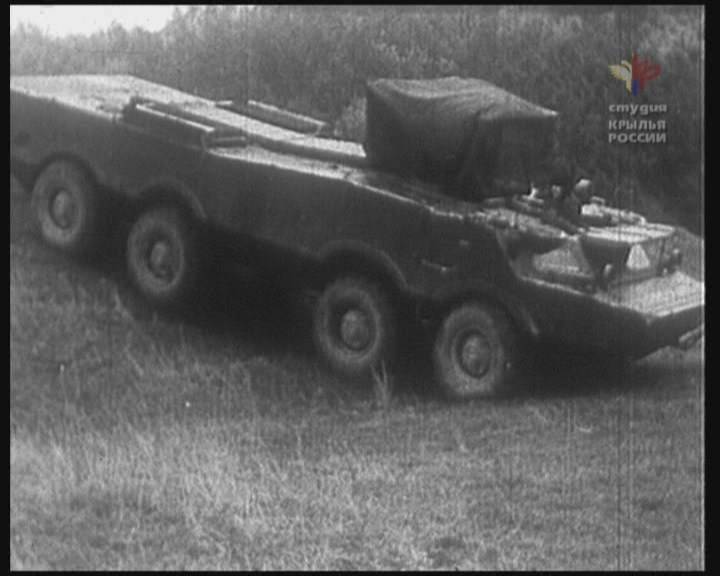
Presumably the prototype chassis for the complex "Hawk" during the tests. Shot from the d / f "Cars in uniform", dir. And Kryukovsky, studio "Wings of Russia"
The rocket of the Yastreb complex was supposed to have a radio command control system. To implement these principles of guidance, the self-propelled launcher received a set of necessary electronic equipment. So, for tracking the rocket in the active part of the flight and determining the parameters of its movement, it was proposed to use our own radar station with the required characteristics. The radar antenna was placed on the roof of the body of the combat vehicle, behind the cockpit, and was covered with a radio-transparent cover.
With the help of the radar, the automatics of the complex had to track the rocket and compare its trajectory with the required one. When deviating from the calculated trajectory, it was necessary to generate commands transmitted to the rocket equipment through the corresponding antenna device. This method of targeting allowed us to provide the required accuracy rates of hitting with the comparative simplicity of the rocket design. All the necessary complex equipment was placed only on a self-propelled launcher.
The controlled ballistic missile of the Yastreb complex was designated B-612. This product was supposed to be based on the B-611 anti-aircraft missile design from the Storm M-11 ship complex. The base anti-aircraft missile was developed by OKB-2, which should greatly simplify the creation of a new weapon. From the existing project with minimal changes borrowed the design of the hull and planes, control system, engine and other units. In addition, there was a need to create some new devices.
The B-612 missile was to receive a complex-shaped body formed by a long conical head fairing, a cylindrical central section and a tapered tail section. It was decided to keep the swept trapezoidal wings of the X-shaped structure in the central part of the body. In the tail remained aerodynamic steering wheels of a similar design. The calculations showed that the use of the required special warhead will lead to a change in the rocket balancing. Because of this, the head fairing had to be equipped with destabilizers of small scope.
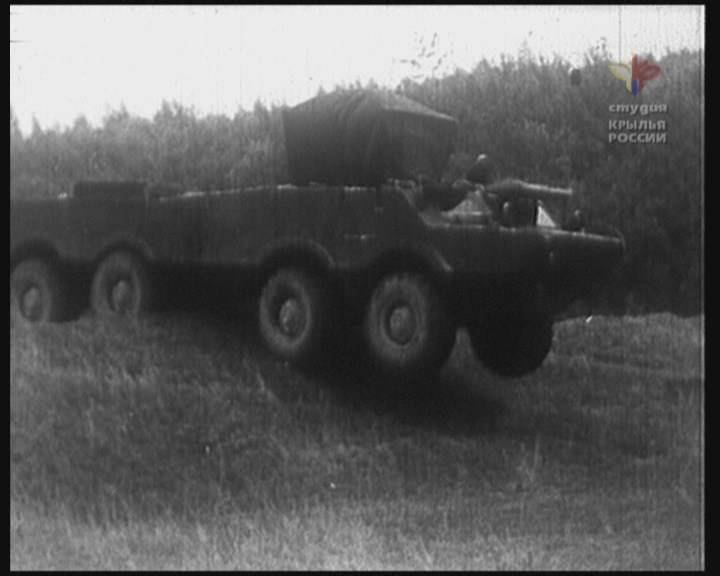
Chassis comes down from obstacles. Shot from the d / f "Cars in uniform", dir. And Kryukovsky, studio "Wings of Russia"
The B-611 anti-aircraft guided missile was equipped with a dual-mode solid-fuel engine, which ensured the launch with the exit from the guide and the subsequent achievement of the target. The engine parameters allowed the rocket to accelerate to 1200 m / s and fly to the target at an average speed of 800 m / s. Due to the large amount of fuel, the engine running time coincided with the flight time to the maximum range of 55 km. A similar solid engine with high performance could be used as part of the В-612 product.
The B-612 rocket control systems were to receive incoming commands from the launcher and convert them into commands for the steering machines. The correction of the trajectory according to the commands of the onboard automation of the combat vehicle was to be carried out throughout the active part of the flight. It was planned to carry out the launch of the rocket on the desired trajectory, after which it could continue an uncontrolled flight until it hit the target.
According to reports, the B-612 product was to be completed only with a special warhead. The power of such combat equipment is unknown. Information about the possibility of the development and use of conventional combat units are not available.
The technical requirements required to ensure the possibility of firing a guided missile at a distance from 8 to 35 km. Interestingly, the B-612 ballistic missile should have been different from the anti-aircraft B-611 in a shorter range. Apparently, the difference in these indicators was due to the need to install a heavier special warhead, which could lead to an increase in the starting weight of the product or to a reduction in engine size with a decrease in the stock of its fuel.
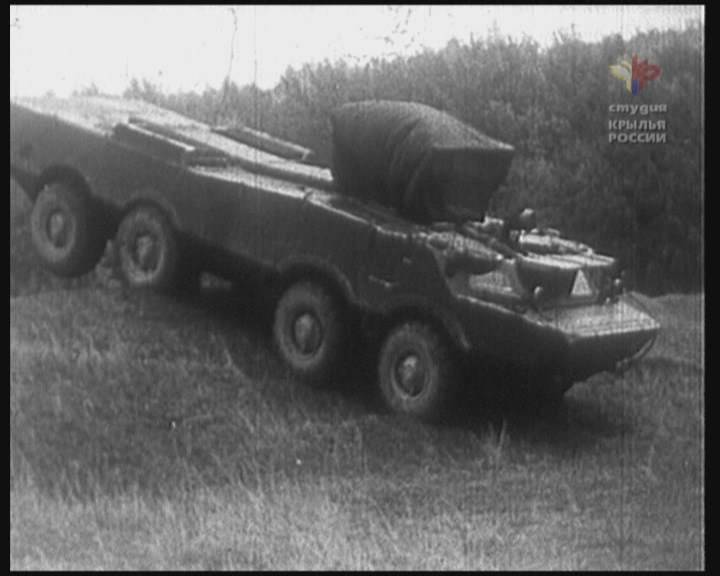
In front of the roof is visible simulator radar tracking the rocket. Shot from the d / f "Cars in uniform", dir. And Kryukovsky, studio "Wings of Russia"
By the end of the first half of the sixties, OKB-2 and related organizations had completed the bulk of the preliminary work on the Hawk project. The main features of the promising missile complex were identified. In addition, its individual elements were brought to the prototype assembly stage with their subsequent tests. Successful completion of such work allowed to continue the creation of the project.
By the Bryansk Automobile Plant, by the 1965-66 years, a prototype of a prospective four-axle chassis was built, intended to be used as the basis for the Yastreb launcher. According to reports, this machine did not receive launcher units, but was equipped with a simulator of the antenna unit of the radar station. Because of this, a large unit appeared on the roof of the hull, behind the cabin, which, for reasons of secrecy, was covered with a canvas cover.
There is information about the tests of the perspective chassis, which allowed to establish the real characteristics of the machine when driving on roads and rough terrain. As shown by the surviving footage of the newsreel, the prototype successfully coped with quite complex obstacles. This fact could open the way to his subsequent use.
According to reports, the development of the complex "Hawk" stopped at the stage of creating a preliminary design. In parallel with the “Hawk”, OKB-2 employees created the “Tochka” complex with a different missile control system. A comparison of the two projects showed that the use of radio command control leads to an excessive complication of the self-propelled launcher. Also, the Yastreb launcher was forced to remain in the firing position for some time after launch, carrying out the launch of the missile on the desired trajectory, because of which it was at great risk. In addition, the unification of ballistic and anti-aircraft missiles did not allow to achieve high rates of firing.
Thus, an interesting and seemingly promising project could hardly arrange an army and reach mass exploitation. No later than 1965-66, the Hawk project was officially closed.
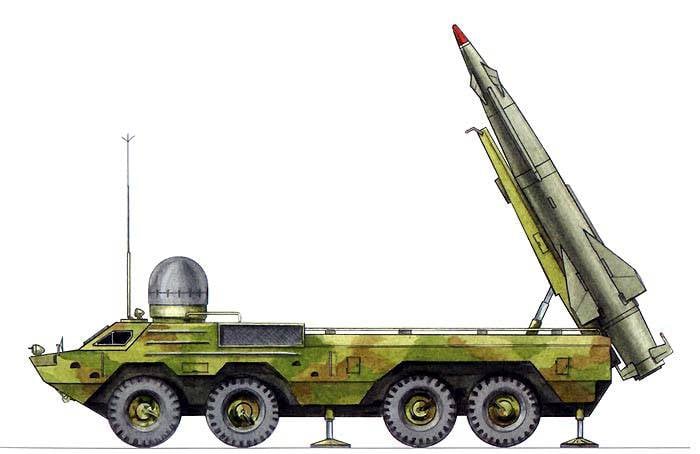
Rocket complex in a combat position. Figure Militaryrussia.ru
As far as is known, by the time the work on the “Hawk” project was completed, only an experimental chassis for a self-propelled launcher was built. Other elements of the complex have not reached the assembly and verification of prototypes. The customer abandoned the new complex before the developers managed to complete the design of its individual systems.
The preliminary study and preliminary design of the tactical missile complex “Yastreb” made it possible to determine the prospects of several original proposals that were its basis. Thus, it was found that even a relatively heavy and large anti-aircraft missile B-611 cannot be the basis for a ballistic missile with the required characteristics of the range and power of the warhead. In addition, the radio command control of the missile did not justify itself in the context of tactical systems for ground forces.
At the same time, considerable experience was gained in the design of missiles and other elements of tactical level complexes. For example, there is reason to believe that the project of a special four-axle chassis was further developed and led to the appearance of the self-propelled launcher 9P714 of the operational-tactical complex 9К714 "Oka". In addition, the Tochka project, which was being developed in parallel with Yastreb, later became the basis for the 9K79 complex with the same additional name.
The project of the tactical missile complex "Yastreb" was not fully implemented. Nevertheless, he allowed to explore some of the original ideas, and then determine their real prospects. It turned out that interesting and promising proposals can hardly be used in practice. Thus, the “Hawk” project did not lead to the emergence of new military equipment, but it contributed to the further development of rocket complexes, showing the failure of some ideas.
On the materials of the sites:
http://pvo.guns.ru/
http://flot.sevastopol.info/
http://militaryrussia.ru/blog/topic-260.html
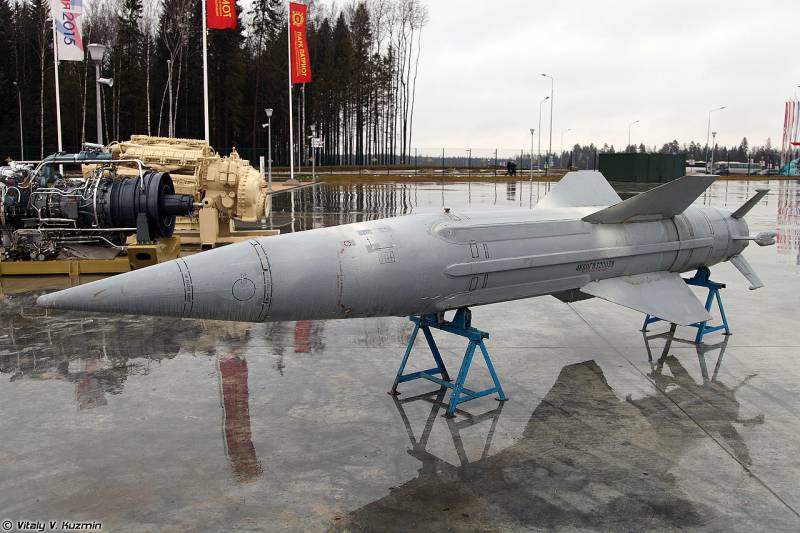
Information